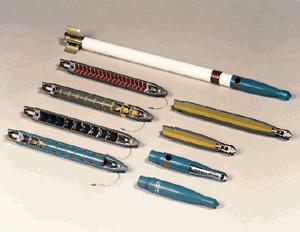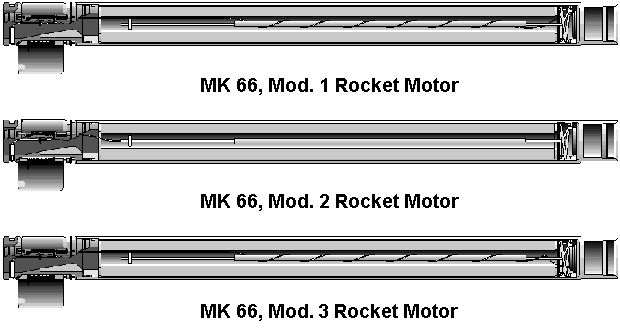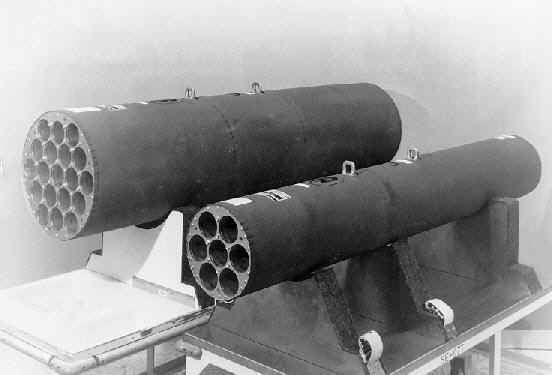
|

|

|

|

Hydra 70 is the name associated with the new family of 2.75 inch (70mm) rockets. Basically, Hydra 70 refers to the MK66 rocket motor with any warhead / fuze combination. The MK66 rocket motor was designed to provide a common 2.75 inch rocket for helicopters and high-performance aircraft. It uses a longer tube, and improved double base solid propellant, and a different nozzle and fin assembly. Increased velocity and spin provide improved trajectory stability for better accuracy. The launch signature and smoke trail have been significantly reduced. The MK66 Mod 1 is not HERO (Hazard of Electronic Radiation to Ordnance) safe. It can be inadvertently ignited by EMR (ElectroMagnetic Radiation), especially by radio frequencies found aboard Navy ships. Both the Mod 2 and 3 have HERO filters, and the Mod 2 filters may prevent the AH-1 RMS from inventorying. The Mod 1 is the standard motor for Army use as will be the Mod 3 when fielded.

| Rocket Motor comparison data | ||
|---|---|---|
| MK66 | MK40 | |
| Length without warhead | 41.7 inches | 39.3 inches |
| Weight before firing | 13.6 lbs. | 11.0 lbs. |
| Burn time (77° F) | 1.05 - 1.10 seconds | 1.55 - 1.69 seconds |
| Average thrust | 1,300 - 1,370 pound | 720 pound |
| Launch spin rate | 9 - 10 revolution per second | 1 revolution per second |
| Motor burnout (warhead type unknown) | 1,280 (397m) ft from launcher | 1,460 (445m) ft from launcher |
| Velocity at motor burnout | 2,425 fps | 1,965 fps |
| Maximum range at QE 43° ground launch
(MPSM warhead) |
10,425m | 8,080 |
MK40 rocket motors are no longer produced for the Army. Inventories for training were expected to be exhausted in FY91. An unknown quantity are held in war reserve stockage. The table above shows rocket motor comparison data.

M260 and M261 launchers are required to fire the MK66 rocket. They have reduced system weight and provide remote set fuze interface capabilities. The M158A1 and M200 launchers are not compatible with the MK66 rocket motor.
M151 High-Explosive. The M151 HE (diagram) is an antipersonnel, antimaterial warhead and is traditionally referred to as the 10-Pounder. The bursting radius is 10 meters; however, high velocity fragments can produce a lethality radius in excess of 50 meters. The nose section is constructed of malleable cast iron which is threaded to receive the fuze. The base section is constructed of steel or cast iron and is threaded so that it can be attached to the rocket motor. The base section and the rocket motor are welded (brazed) together. Total weight of the loaded, unfuzed, warhead is 8.7 pounds, of which 2.3 pounds is composition B4. The M151 can use M423, M429, or M433 fuzes.
M156 White Phosphorous (Smoke). The M156 (diagram) is primarily used for target marking and incendiary purposes. It ballistically matches the M151 and is of similar construction. Filler for the M156 is 2,2 pounds of WP with .12-pound bursting charge of composition B. The approximate weight of the fuzed warhead is 9.7 pounds. M423 or M429 fuzes can be used with 156.
M229 High-Explosive. The M229 HE (diagram) warhead is currently in the inventory. An elongated version of the M151, it is commonly referred to as the 17-Pounder. The M229 filler consists of 4.8 pounds of composition B4 and can use the same fuzes as the M151. Its unfuzed weight is 16.4 pounds.
M247 High-Explosive, Dual-Purpose. The M247 (diagram) is no longer in production; however, some of these warheads may still be found in war reserve stockage. With a shape charge for antiarmor capability, the M247 employs a cone-shaped charge like that of the M72 LAW. The point-initiated detonating fuze is an integral part of the warhead. The weight of the M247 is 8.8 pounds, of which 2.0 pounds is composition B.
M257 Illumination. The M257 (diagram) illumination warhead provides one million candlepower for 100 seconds or more. It can illuminate an area in excess of one square kilometer at optimum height. A deployed main parachute descent is approximately 15 feet per second. An M442 integral fuze provides a standoff range of approximately 3,000 meters with the MK40 motor and approximately 3,500 meters with the MK66 motor. The weight of the M257 is 10.8 pounds, of which 5.4 pounds is magnesium sodium nitrate.
M259 Smoke-Screening (White Phosphorous) The M259 (diagram) smoke-screening warhead is in inventory but is not currently being produced. It provides the capability to produce tactical smoke screens. With conditions favorable to smoke operation, 14 rockets can produce an effective smoke screen for 5 minutes. With a motor burnout fuze (M446) and an MK40 motor, the warhead can provide a stand-off range of 2,500 to 3,000 meters. The weight of the warhead is 8.8 pounds. An improved smoke warhead, the M264 smoke screen (red phosphorous) is in development to replace the M259. The M264 will employ the M439 fuze.
M261 High-Explosive Multi-purpose submunition. The MPSM HE (diagram) warhead provides improved lethal effectiveness against area targets such as light armor, wheeled vehicles, material, and personnel. It has a plastic nose cone assembly, an aluminum warhead case, an integral fuze, an expulsion charge, and nine M73 (diagram) submunitions. The primary warhead fuze (M439) is remotely set with the ARCS, MFD, or RMS to provide range (time of flight) from 500 meters to approximately 7,000 meters. On the AH-1, the RMS is programmable only from 700 meters to 6,900 meters.
Initial forward motion of the rocket at firing initiates fuze timing. At fuze time an at a point before and above the target, depending on the launch angle and range, the expulsion charge is initiated. The SMs are separated by ejection, and arming occurs when the RAD (ram air decelerator) deploys. The RAD virtually stops forward velocity and stabilizes the decent of the SM. An M230 omnidirectional fuze with an M55 detonator is used on each SM and is designed to function regardless of the impact angle.
Each SM has a steel body which has a 3.2-ounce shaped charge of composition B for armor penetration. The SM is internally scored to optimize fragments against personnel and material. Upon detonation, the shaped charge penetrates in line with its axis and the SM body explodes into high velocity fragments (approximately 195 at 10 grains each up to 5,000 feet per second) to defeat soft targets. The fuzed weight of the M261 is 13.6 pounds.
M267 MPSM Smoke Signature (Training). The M267 MPSM (diagram) training warhead operationally, physically, and ballistically matches the M261. Three M75 practice SMs and six inert SM load simulators take the place of nine HE submunitions in the M261 warhead. Like the M274, each of the three practice SMs contains approximately 17 grams ( 0.6 ounces of pyrotechnic powder. An M231 fuze with an M55 detonator is used with practice SMs.
M274 Smoke Signature (Training). The M274 (diagram) smoke signature training rocket provides a ballistic match for the M151HE warhead. The casing is a modified WTU-1/B with vent holes or blowout plugs. A modified M423 fuze mechanism is integral to the warhead. A cylindrical cartridge assembly is in the forward section of the casing; it contains approximately 1.4 ounces of potassium perchlorate and aluminum powder which provides a "flash, bang, and smoke" signature. The M274 weighs 9.3 pounds.
Flechette, WDU (4A/A). The 4A/A (diagram) flechette is not currently in production. Used primarily for antipersonnel operations, this warhead contains approximately 2,200 twenty grain flechettes. The flechettes are released by a base-mounted, fuze-ignited (integral fuze) expulsion charge at rocket motor burnout. Fuzed weight of the flechette is 9.3 pounds.
The M255E1 flechette warhead, which contains approximately 1,180 sixty-grain hardened steel flechettes, is in limited production. It has possible air-to-air as well as air-to-ground application. The M255E1 is designed for use with the M439 fuze.
M423 Point-Detonating. The M423PD (diagram) fuze is an oblique sensitive, point-detonating, superquick fuze used as a common component with the M151. The safety and arming device forward of the booster housing (explosive charge) contains an unbalanced rotor. Upon acceleration of the rocket at firing, a weight setback occurs in the unbalanced rotor assembly which houses the primer and detonator. This setback places the fuze into an armed condition when the rocket has traveled approximately 43 to 92 meters from the launcher.
M429 Proximity. Currently in inventory, the M429 (diagram) proximity fuze is a transistorized, continuous-wave, doppler device that provides airburst functioning for improved antipersonnel effectiveness. The arming mechanism of the M429 is similar to the one in the M423 except that it has been modified to include a battery and an electric detonator. Once it is armed and the reflected signals reach a specific intensity, the firing circuit is initiated through a capacitor to the electric detonator that provides the airburst function. A superquick impact switch serves as a backup to the airburst electronics.
M433 Resistance Capacitance. The M433 (diagram) RC fuze is a nose-mounted, multi-option time delay fuze with selectable functioning modes. A superquick setting is used for open terrain; a forest penetration mode permits a selectable time delay range (10 to 45 meters in 5-meter increments) set for the height of the forest canopy. After first contact with the forest, a delay timer is activated to provide warhead functioning. The bunker or building penetration mode provides up to 10 feet of penetration before detonation. The target penetration RC timer is activated by a point-mounted probe switch that is initiated by target contact. An umbilical assembly is positioned on the nose of the fuze for interface through the launcher and the RMS or the ARCS and the aircraft. When the trigger is pulled, aircraft voltage is supplied to the fuze and time delay is initiated as selected by the pilot.
M439 Resistance Capacitance. The M439 RC (diagram) fuze is a base-mounted, electronic-variable, time-delay fuze with an RC delay circuit. Designed for cargo and flechette warheads, the M439 allows the pilot to set the fuze remotely for airburst functioning at the desired range from 500 to approximately 7,000 meters. A fuze capacitor is charged by the RMS, ARCS or MFD through an umbilical assembly. The fuze has no internal battery, and the required voltage is supplied by the aircraft through the remote-set fuze sub-system. When the rocket is fired and normal acceleration occurs, the fuze is armed and timing starts. If the fuze is set but the rocket motor fails to fire, the rocket may be loaded into another tube and fired. When the fuze is set a second time, it will function longer than the set time and should not be used for accurate measurement until 10 days has elapsed before resetting it. Depending on the range setting (time of flight), the detonator is initiated electrically and ignites the expelling charge.
M422/M446 Fuzes. The M422 and M446 fuzes are base-mounted, airburst, motor-burnout delayed fuzes. They are integral fuzes used with the M257 illumination and M259 WP smoke rockets, respectively. The M446 is also used on the 4A/A WDU flechette warhead.
|
|
|
|
| Updated: 12 January 2008 | Born on 22 October 1998 |